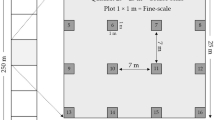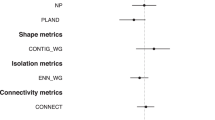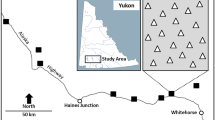Abstract
Giant squirrels are imperilled across their distributional range as a result of anthropogenic disturbances; converting tropical landscapes into mosaics of small habitat patches interspersed within an inhospitable matrix of agricultural land, plantations and human settlement. With limited understanding of Ratufa bicolor’s habitat relations in the lowland tropical forests, this study aimed to understand the correlates of habitat use from an isolated habitat patch and its adjoining matrix in the Brahmaputra valley which represents the northern distribution limit of the species. The ecological dataset comprised of grid-based spatial occurrence data summarized as average squirrel encounter rate (4 temporal replicate transect surveys in each grid), as well as a range of fine spatial scale ecological covariates (14 habitat attributes). We used generalized linear models and principal component analysis to characterize relationships between squirrel abundance and habitat variables representing different aspects of forest, i.e., structure, composition and food availability, anthropogenic disturbance and edge influence. Our study revealed giant squirrels’ selection of habitat patches to be based on concentrated areas of critical habitat attributes with strong support for the influence of canopy connectivity, canopy density, overall tree density and availability of food tree. Further, a quantitative model for habitat use was evaluated using GLM linking squirrel abundance to the predictive parameters representing different forest aspects, with the best fit model highlighting the positive interaction effects of forest structure and forest composition. The findings from the study provide insights into the necessity of maintaining associated habitat matrix to serve as complimentary space, ensuring future survival of arboreal mammals in human-modified landscapes.





Similar content being viewed by others
Data availability
The raw data and the codes used are available from the corresponding author upon request.
References
Adler GH (2000) Tropical tree diversity, forest structure and the demography of a frugivorous rodent, the spiny rat (Proechimys semispinosus). J Zool 250(1):57–74
Agetsuma N (1995) Foraging strategies of Yakushima macaques (Macaca fuscatayakui). Int J Primatol 16(4):595–609
Baldellou M, Henzi SP (1992) Vigilance, predator detection and the presence of supernumerary males in vervet monkey troops. Anim Behav 43(3):451–461
Bartoń K (2020) MuMIn: multi-model inference. R Package Version 1(43):17
Baskaran N, Senthilkumar K, Saravanan M (2011) A new site record of the Grizzled Giant Squirrel Ratufa macroura (Pennant, 1769) in the Hosur forest division, Eastern Ghats, India and its conservation significance. J Threat Taxa 3(6):1837–1841
Baskent EZ, Jordan GA (1996) Designing forest management to control spatial structure of landscapes. Landsc Urban Plan 34(1):55–74
Borges RM (1989) Resource heterogeneity and the foraging ecology of the Malabar Giant Squirrel, Ratufa indica. Doctoral dissertation, University of Miami
Borges RM (1993) Figs, Malabar giant squirrels, and fruit shortages within two tropical Indian forests. Biotropica 25(2):183–190
Borges RM (2008) Why are there so many giants, including giant squirrels, in the Old World tropics? Curr Sci 95:866–870
Breheny P, Burcheet W (2017) Visualisation of regression models using visreg. R Journal 9:56–71
Bujarbarua P, Sarma SK (2004) An assessment of the floristic diversity of Gibbon wildlife sanctuary, Assam, India. Phytotaxonomy 4:124–130
Burke DM, Nol E (1998) Edge and fragment size effects on the vegetation of deciduous forests in Ontario, Canada. Nat Areas J 18(1):45–53
Burnham KP, Anderson DR (2002) Model selection and multi-model inference: a practical information-theoretic approach, 2nd edn. Springer-Verlag, New York, pp 70–71
Chatterjee P, Tripathy B, Chandra K, Saha GK, Mondal K (2020) Climate change alarms the survival of Near Threatened species Malayan giant squirrel (Ratufa bicolour Sparrman, 1778) in India. Mammal Study 45(4):289–302
Chaturvedi AN, Khanna LS (1982) Forest mensuration. International Book Distributors, Dehradun, India
Choudhury A (1999) Primates in gibbon sanctuary Assam, India. Asian Primates 7(1–2):4–6
Choudhury A (2013) The mammals of North east India. Gibbon Books, Guwahati, India
Chowdhury A, Samrat A, Devy MS (2021) Can tea support biodiversity with a few “nudges” in management: evidence from tea growing landscapes around the world. Glob Ecol Conserv 31:1801
Cody ML (1985) Habitat selection in birds. Academic press INC, London
Cudney-Valenzuela SJ, Arroyo-Rodríguez V, Andresen E et al (2021) Does patch quality drive arboreal mammal assemblages in fragmented rainforests? Perspect Ecol Conserv 19(1):61–68
Datta A (1993) Space-use pattern of the Indian giant squirrel (Ratufa indica centralis) in relation to food availability in Bori Wildlife Sanctuary, Madhya Pradesh, India. Doctoral dissertation, M. Rajkot: Saurashtra University
Datta A, Goyal SP (1996) Comparison of forest structure and use by the Indian giant squirrel (Ratufa indica) in two riverine forests of Central India. Biotropica 28:394–399
Datta A, Goyal SP (2008) Responses of diurnal tree squirrels to selective logging in western Arunachal Pradesh. Curr Sci 95:895–902
de Castro EBV, Fernandez FA (2004) Determinants of differential extinction vulnerabilities of small mammals in Atlantic Forest fragments in Brazil. Biol Conserv 119(1):73–80
Dobrovolski R, Diniz-Filho JAF, Loyola RD et al (2011) Agricultural expansion and the fate of global conservation priorities. Biodivers Conserv 20(11):2445–2459
Dodd NL, Schweinsburg RE, Boe S (2006) Landscape-scale forest habitat relationships to tassel-eared squirrel populations: Implications for ponderosa pine forest restoration. Restor Ecol 14(4):537–547
Driscoll DA, Banks SC, Barton PS et al (2013) Conceptual domain of the matrix in fragmented landscapes. Trends Ecol Evol 28(10):605–613
Duckworth JW, Molur S (2016) Ratufa bicolor. The IUCN Red List of Threatened Species2016:e.T19377A22261810
Dunn JC, Asensio N, Arroyo-Rodríguez V et al (2012) The ranging costs of a fallback food: liana consumption supplements diet but increases foraging effort in howler monkeys. Biotropica 44(5):705–714
Eisenberg JF (1980) The density and biomass of tropical mammals. In: Soule ME, Wilcox BA (eds) Conservation Biology. Sinauer, Sunderland, MA, pp 35–55
Emmons LH, Gentry AH (1983) Tropical forest structure and the distribution of gliding and prehensile-tailed vertebrates. Am Nat 121(4):513–524
Environmental Systems Research Institute (ESRI) (2014) ArcGIS Release 10.2. Redlands, CA
Fahrig L (2013) Rethinking patch size and isolation effects: the habitat amount hypothesis. J Biogeogr 40(9):1649–1663
Franklin JF, Lindenmayer DB (2009) Importance of matrix habitats in maintaining biological diversity. Proc Natl Acad Sci 106(2):349–350
Gibbs HK, Ruesch AS, Achard F et al (2010) Tropical forests were the primary sources of new agricultural land in the 1980s and 1990s. Proc Natl Acad Sci 107:16732–16737
Hansen MC, Potapov PV, Moore R et al (2013) High-resolution global maps of 21st-century forest cover change. Science 342(6160):850–853
Hazarika R, Gupta AK (2005) Resource sharing by Hoolock Gibbon (Bunopithecus hoolock) with two primate species in Gibbon Wildlife Sanctuary, Assam, India, Conservation of Hoolock Gibbon (Bunopithecus hoolock) in Northeast India. Wildlife Institute of India, Dehradun, pp 233–257
Herbers JIM, Klenner W (2007) Effects of logging pattern and intensity on squirrel demography. J Wildl Manage 71(8):2655–2663
Herlekar IR (2010) Effect of canopy fragmentation on the patterns of habitat use of the grizzled giant squirrel Ratufa macroura in Cauvery Wildlife Sanctuary, Karnataka, India. Dissertation, Tata Institute of Fundamental Research, Bengaluru
Irwin MT (2008) Feeding ecology of Propithecus diadema in forest fragments and continuous forest. Int J Primatol 29(1):95–115
Islam S (2002) Effects of selective logging on tree species diversity, stand structure and physical environment of tropical hill dipterocarp forest of Peninsular Malaysia. Dissertation, University of Kebangsaan, Malaysia
Johnsingh AJT, Manjrekar N (2016) Mammals of South Asia, vol II. University Press, India
Joshua J (1992) Ecology of the endangered grizzled giant squirrel Ratufa macroura in Tamil Nadu, south India. Dissertation, Bharathidasan University
Joshua J, Johnsingh AJT (1994) Impact of biotic disturbances on the habitat and population of the endangered grizzled giant squirrel Ratufa macroura in South India. Biol Conserv 68(1):29–34
Kakati K, Raghavan R, Chellam R et al (2009) Status of Western Hoolock Gibbon (Hoolock hoolock) populations in fragmented forests of eastern Assam. Primate Conserv 24(1):127–137
Kays R, Allison A (2001) Arboreal tropical forest vertebrates: current knowledge and research trends. Plant Ecol 153(1–2):109–120
Koprowski JL (2005) The response of tree squirrels to fragmentation: a review and synthesis. Anim Conserv 8(4):369–376
Koprowski JL, Nandini R (2008) Global hotspots and knowledge gaps for tree and flying squirrels. Curr Sci 95:851–856
Krausman PR (1999) Some basic principles of habitat use. Grazing Behav Livest Wildl 70:85–90
Laurance WF (1991) Edge effects in tropical forest fragments: application of a model for the design of nature reserves. Biol Conserv 57(2):205–219
Laurance WF (2007) Forest destruction in tropical Asia. Curr Sci 93:1544–1550
Laurance WF (2015) Emerging threats to tropical forests, treetops risk challenges glob. Canopy Ecol Conserv 100(3):71–79
Laurance WF, Delamonica P, Laurance SG et al (2000) Rainforest fragmentation kills big trees. Nature 404(6780):836
Laurance WF, Lovejoy TE, Vasconcelos HL et al (2002) Ecosystem decay of Amazonian forest fragments: a 22-year investigation. Conserv Biol 16(3):605–618
Lehman SM (2007) Ecological and phylogenetic correlates to body size in the Indriidae. Int J Primatol 28(1):183–210
MacKinnon KS (1978) Stratification and feeding differences among Malayan squirrels. Malayan Nat J 30:591–608
Maddala GS (1977) Econometrics. McGraw Hills publication Company, New York
Malcolm JR (2004) Ecology and conservation of canopy mammals. In: Lowman MD, Rinker HB (eds) Forest canopies. Elsevier, San Diego, pp 175–211
Marsh LK, Chapman CA, Arroyo-Rodríguez V, Cobden AK, Dunn JC, Gabriel D, Ghai R, Nijman V, Reyna-Hurtado R, Serio-Silva JC, Wasserman MD (2013) Primates in fragments 10 years later: once and future goals. In: Primates in fragments. Springer, New York, pp 505–525
Mayaux P, Holmgren P, Achard F et al (2005) Tropical forest cover change in the 1990s and options for future monitoring. Philos Trans R Soc B Biol Sci 360(1454):373–384
Murcia C (1995) Edge effects in fragmented forests: Implications for conservation. Trends Ecol Evol 10(2):58–62
Myers N, Knoll AH (2001) The biotic crisis and the future of evolution. Proc Natl Acad Sci USA 98(10):5389–5392
Nandini R, Parthasarathy N (2008) Food habits of the Indian giant flying squirrel (Petaurista philippensis) in a rain forest fragment, Western Ghats. J Mammal 89(6):1550–1556
Nath A, Singha H, Haque M et al (2019) Sparrows in urban complexity: macro and micro-scale habitat use of sympatric sparrows in Guwahati City. India Urban Ecosyst 22(6):1047–1060
Payne JB (1979) Synecology of Malayan tree squirrels with special reference to the genus Ratufa. Doctoral dissertation, University of Cambridge
Phillips EA (1959) Methods of vegetation study. Henry Holt, New York, US
R Development Core Team (2019) R: A Language and Environment for Statistical Computing. R Foundation for Statistical Computing, Vienna, Austria
Ramachandran KK (1988) Ecology and behaviour of Malabar Giant Squirrel Ratufa indica maxima (Schreber, 1788). Report of the Project Wild 04/83. Division of Wildlife Biology, Kerala for Res Inst Peechi Kerala
Ramachandran KK, Joseph GK (2000) Habitat utilization of lion-tailed macaque (Macaca silenus) in silent valley national park, Kerala India. Primate Rep 58:17–26
Raman TS, Gonsalves C, Jeganathan P et al (2021) Native shade trees aid bird conservation in tea plantations in southern India. Curr Sci 121(2):294–305
Ransome DB, Sullivan TP (1997) Food limitation and habitat preference of Glaucomys sabrinus and Tamiasciurus Hudsonicus. J Mammal 78(2):538–549
Roth VL, Mercer JM (2008) Differing rates of macroevolutionary diversification in arboreal squirrels. Curr Sci 95:857–861
Saiful AA, Nordin M (2004) Diversity and density of diurnal squirrels in a primary hill dipterocarp forest. Malaysia J Trop Ecol 20(1):45–49
Sarkar M, Devi A (2014) Assessment of diversity, population structure and regeneration status of tree species in Hollongapar Gibbon Wildlife Sanctuary, Assam, Northeast India. Trop Plant Res 1(2):26–36
Selonen V, Hanski IK, Stevens PC (2001) Space use of the Siberian flying squirrel Ptevomys volans in fragmented forest landscapes. Ecography 24(5):588–600
Sengupta S (2017) Ecology and resource partitioning of sympatric species of squirrels in Hollangapar Gibbon Wildlife Sanctuary, Assam, India. Doctoral dissertation, Assam University, India
Sengupta S, Singha H, Deb P (2016) Ground foraging behaviour of Malayan giant squirrel (Ratufa bicolor). Curr Sci 110(12):2223–2225
Sharma N, Madhusudan MD, Sarkar P et al (2012) Trends in extinction and persistence of diurnal primates in the fragmented lowland rainforests of the Upper Brahmaputra Valley, north-eastern India. Oryx 46(2):308–311
Sharma N, Madhusudan MD, Sinha A (2014) Local and landscape correlates of primate distribution and persistence in the remnant lowland rainforests of the upper Brahmaputra valley, Northeastern India. Conserv Biol 28(1):95–106
Shyam C, Saikia P (2012) Nesting habitat characteristics and food habits of Malayan giant squirrel Ratufa bicolor (Sparrmann, 1778) in Gibbon wildlife sanctuary, Jorhat, Assam, India. Ecoscan 6:73–78
Singh M, Kumara HN, Kumar MA et al (2000) Status and conservation of lion-tailed macaque and other arboreal mammals in tropical rainforests of Sringeri Forest Range, Western Ghats, Karnataka, India. Primate Rep 58:5–16
Sridhar H, Raman TS, Mudappa D (2008) Mammal persistence and abundance in tropical rainforest remnants in the southern Western Ghats, India. Curr Sci 97:748–757
Srinivas V, Venugopal PD, Ram S (2008) Site occupancy of the Indian giant squirrel Ratufa indica (Erxleben) in Kalakad-Mundanthurai Tiger Reserve, Tamil Nadu, India. Curr Sci 95:889–894
Taubert F, Fischer R, Groeneveld J (2018) Global patterns of tropical forest fragmentation. Nature 554(7693):519–522
Thorington RW Jr, Cifelli RL (1990). In: Daniel JC, Serrao JS (eds) Conservation in developing countries: problems and prospects. Oxford University Press, Mumbai, pp 212–219
Thorington RW Jr, Koprowski JL, Steele MA et al (2012) Squirrels of the World. Johns Hopkins University Press, Baltimore, MD
Turner IM, Corlett RT (1996) The conservation value of small, isolated fragments of lowland tropical rain forest. Trends Ecol Evol 11(8):330–333
Umapathy G, Kumar A (2000) The occurrence of arboreal mammals in the rain forest fragments in the Anamalai Hills, south India. Biol Conserv 92(3):311–319
Vamosi JC, Vamosi SM (2008) Extinction risk escalates in the tropics. PLoS One 3(12):e3886
Verbeylen G, Wauters LA, De Bruyn L et al (2009) Woodland fragmentation affects space use of Eurasian red squirrels. Acta Oecologica 35(1):94–103
Volenec ZM, Dobson AP (2020) Conservation value of small reserves. Conserv Biol 34(1):66–79
Wauters LA, Somers L, Dhondt A (1997) Settlement behaviour and population dynamics of reintroduced red squirrels Sciurus vulgaris in a park in Antwerp, Belgium. Biol Conserv 82(1):101–107
Whitmore TC, Sayer JA (1992) Deforestation and species extinction in tropical moist forests. Tropical deforestation and species extinction. Chapman & Hall, London, pp 1–14
Whitworth A, Beirne C, Pillco Huarcaya R et al (2019) Human disturbance impacts on rainforest mammals are most notable in the canopy, especially for larger-bodied species. Divers Distrib 25(7):1166–1178
Wickham H (2016) ggplot2: elegant graphics for data analysis. Springer-Verlag, New York
Acknowledgements
This study was financed in part by WWF small grants programme (2013) and UGC-BSR fellowship (2013–16) during the period of first author’s (SS) doctoral research work at Assam University, Silchar (registration no. Ph.D/2094/2012). Field work at the study site was authorized by Principal Chief Conservator of Forest and Chief Wildlife Warden of Assam (vide permission letter no. WL/FG.31/Pt/2013, dated 14.08.2013). We thank Dr. Anukul Nath (Wildlife Institute of India, Dehradun, India) and Dr. Narayan Sharma (Cotton State University, Guwahati, India) for suggesting valuable reference material and also for providing crucial analytical insights. We would also like to thank Mr. Nilutpal Mahanta and our field assistants Dilip Boruah and Late Noren Bhuyan for accompanying us during the field surveys. We are also highly grateful and appreciate the time and effort that the two anonymous reviewers have dedicated to provide the valuable suggestions on our manuscript.
Author information
Authors and Affiliations
Corresponding author
Ethics declarations
Conflict of interest
On behalf of all authors, the corresponding author states that there is no conflict of interest.
Additional information
Handling editor: Raquel Monclús.
Publisher's Note
Springer Nature remains neutral with regard to jurisdictional claims in published maps and institutional affiliations.
Supplementary Information
Below is the link to the electronic supplementary material.
Rights and permissions
Springer Nature or its licensor (e.g. a society or other partner) holds exclusive rights to this article under a publishing agreement with the author(s) or other rightsholder(s); author self-archiving of the accepted manuscript version of this article is solely governed by the terms of such publishing agreement and applicable law.
About this article
Cite this article
Sengupta, S., Deb, P., Arandhara, S. et al. Ecological correlates of giant squirrel (Ratufa bicolor) microhabitat use in a lowland tropical forest: implications for matrix management. Mamm Biol 103, 107–119 (2023). https://doi.org/10.1007/s42991-022-00329-0
Received:
Accepted:
Published:
Issue Date:
DOI: https://doi.org/10.1007/s42991-022-00329-0




